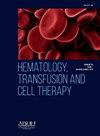LYSOZYME-INDUCED NEPHROPATHY IN CMML: A RARE BUT SIGNIFICANT COMPLICATION REQUIRING EARLY RECOGNITION AND INTERVENTION
IF 1.6
Q3 HEMATOLOGY
引用次数: 0
Abstract
Background
CMML is a clonal hematopoietic disorder with features of myelodysplasia and myeloproliferation, characterized by monocytosis. Monocytes secrete lysozyme, a cationic protein filtered by the glomerulus and reabsorbed in proximal tubules. Excess lysozyme accumulation causes tubular injury, leading to Lysozyme-Induced Nephropathy (LyN).
Case 1
A 72-year-old male with CMML that transformed into AML with a TP53 mutation. Laboratory results showed WBC 9 × 10⁹/L, Hb 80 g/Platelets 139 × 10⁹/L, and creatinine 162 µmoL/L. Additional findings included Na 129 mmoL/L, Cl 97 mmoL/L, Mg 0.51 mmoL/L, PO4 1.50 mmoLL, and 24-hour urine protein of 1.20 g/L. LyN was suspected and confirmed with a lysozyme level of 117 mcg/mL (2.7‒9.4). He was treated with Azacitidine and Venetoclax, achieving CR and normal renal function.
Case 2
A 60-year-old male with CMML initially presented with a creatinine level of 139 µmoL/L, Na 130 mmoL/L, K 2.6 mmoL/L, normal Magnesium, and a lysozyme level of 153 mcg/mL. His creatinine normalized with prednisone. He progressed to AML after six cycles of Azacitidine and later received four cycles of Venetoclax, achieving CR. Unfortunately, he passed away 18-months post-diagnosis due to pneumonia and pulmonary hemorrhage.
Case 3
A 57-year-old female with CMML transformed into AML underwent MSD SCT but relapsed after five months. She initially achieved CR with Aza-Ven, followed by DLI, but relapsed again after four years. She was unresponsive to Aza-Ven but improved with palliative cytarabine. Initially, she had AKI due to TLS, which improved with chemotherapy. During her last relapse, she had creatinine of 154 µmoL/L, lysozyme levels 124 mcg/mL and electrolyte imbalances. Her renal function significantly improved after cytarabine injections.
Discussion/Conclusion
Most frequent renal complications in CMML are LyN (56%) and renal infiltration by the CMML with incidence of AKI (34.9%) and CKD (7.6%). LyN is a rare and poorly understood complication of CMML. Filtered lysozyme accumulates in the renal cortex, causing severe hypokalemia via kaliuresis or direct tubular injury, potentially leading to kidney failure. In our patient CMML treatment, hydration and steroids restored kidney function. LyN in CMML necessitates early recognition and intervention to improve renal outcomes. Further research is needed to optimize treatment strategies.
cmml溶菌酶引起的肾病:一种罕见但重要的并发症,需要早期识别和干预
cmml是一种以骨髓增生和骨髓增生为特征的克隆性造血疾病,以单核细胞增多为特征。单核细胞分泌溶菌酶,溶菌酶是一种阳离子蛋白,经肾小球过滤后在近端小管中再吸收。过量的溶菌酶积累引起肾小管损伤,导致溶菌酶诱导肾病(LyN)。病例1A 72岁男性CMML转化为AML伴TP53突变。实验室结果:WBC 9 × 10⁹/L, Hb 80 g/血小板139 × 10⁹/L,肌酐162µmoL/L。Na 129 mmoL/L, Cl 97 mmoL/L, Mg 0.51 mmoL/L, PO4 1.50 mmoL/L, 24小时尿蛋白1.20 g/L。溶菌酶水平为117 mcg/mL(2.7-9.4),怀疑为LyN。患者给予阿扎胞苷和Venetoclax治疗,达到CR和肾功能正常。病例2A 60岁男性CMML患者最初表现为肌酐水平139 μ moL/L, Na 130 mmoL/L, K 2.6 mmoL/L,镁正常,溶菌酶水平153 mcg/mL。强的松使他的肌酐恢复正常。患者在阿扎胞苷治疗6个周期后发展为急性髓性白血病,随后又接受了4个周期的Venetoclax治疗,达到CR。不幸的是,患者在诊断后18个月因肺炎和肺出血去世。病例3A, 57岁女性,CMML转化为AML,行MSD SCT, 5个月后复发。她最初使用Aza-Ven达到CR,随后使用DLI,但四年后再次复发。她对Aza-Ven无反应,但姑息性阿糖胞苷改善。最初,她因TLS而患有AKI,化疗后病情有所改善。在她最后一次复发时,她的肌酐为154µmoL/L,溶菌酶水平为124µg/mL,电解质失衡。阿糖胞苷注射后肾功能明显改善。讨论/结论CMML最常见的肾脏并发症是LyN(56%)和CMML肾浸润,AKI(34.9%)和CKD(7.6%)发生率最高。LyN是cml中一种罕见且难以理解的复杂性。滤过的溶菌酶在肾皮层积聚,通过钾尿或直接肾小管损伤引起严重的低钾血症,可能导致肾衰竭。在我们的患者CMML治疗中,水合作用和类固醇恢复了肾功能。CMML中的LyN需要早期识别和干预以改善肾脏预后。需要进一步的研究来优化治疗策略。
本文章由计算机程序翻译,如有差异,请以英文原文为准。
求助全文
约1分钟内获得全文
求助全文
来源期刊

Hematology, Transfusion and Cell Therapy
Multiple-
CiteScore
2.40
自引率
4.80%
发文量
1419
审稿时长
30 weeks
 求助内容:
求助内容: 应助结果提醒方式:
应助结果提醒方式:


